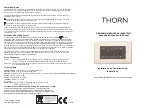
262
Network Administration: Security
FILE LOCATION: C:\Users\gina\Desktop\Checkout_new\Dell Astute\User
Guide\Dell_Astute_Network_Admin_Security.fm
D E L L C O N F ID E N T IA L – P R E L IM I N A R Y 8 / 9 /1 6 - FO R PR O O F O N L Y
• MAC-Based ACEs
• IPv4-Based ACLs
• IPv4-Based ACEs
• IPv6-Based ACLs
• IPv6-Based ACEs
• ACL Binding
• Proprietary Protocol Filtering
• Time Range Configuration
Overview
Access Control Lists (ACLs) enable network managers to define classification
actions and rules for specific ingress or egress ports. Packets entering an
ingress or egress port, with an active ACL, are either admitted or denied entry.
If entry is denied, the ingress or egress port may be disabled, for example, a
network administrator defines an ACL rule that states that port number 20
can receive TCP packets, however, if a UDP packet is received, the packet is
dropped.
ACLs are composed of Access Control Entries (ACEs) that are rules that
determine traffic classifications. Each ACE is a single rule, and up to 256
rules may be defined on each ACL, and up to 3000 rules globally.
Rules are not only used for user configuration purposes, they are also used for
features like DHCP Snooping, and Protocol Group VLAN, so that not all
3000 rules are available for ACEs. It is expected that there will be at least 2000
rules available. If there are fewer rules available, this may be due to DHCP
Snooping. Reduce the number of entries in DHCP Snooping to free rules for
ACEs.
The following types of ACLs can be defined:
•
MAC-based ACL
— Examines Layer 2 fields only
•
IPv4-based ACL
—Examines the Layer 3 layer of IPv4 frames
•
IPv6-based ACL
—Examines the Layer 3 layer of IPv6 frames
MAC-Based ACLs
To define a MAC-based ACL:
















































